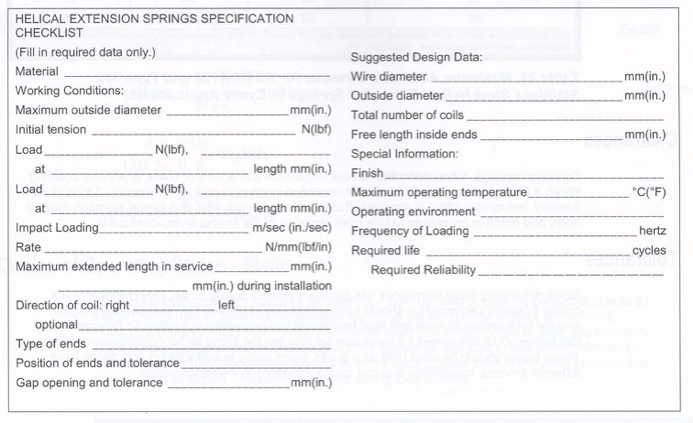The section below gives technical information on extension spring design. Our capabilities are shown and include different body shapes, wire diameter ranges, spring dimensional images, types of extension spring hooks and other consideration that might have an impact on the extension spring used in your application.
Technical illustrations provided by the “Spring Manufacturers Institute Handbook Of Spring Design”
Springs are a more technically engineered product than some people realize. Extension springs can need even more design consideration than compression springs. Industrial Spring has been manufacturing custom extension springs to meet client expectations for more than 50 years. We use Advanced Spring Design software that is based on the Spring Manufacturers Institute Handbook of Spring Design to assist you in developing the best design to work in your specific application. Just contact us at 816-741-6073 and we will be glad to help.
This diagram illustrates the dimensions of an extension spring. Below is a list of some commonly used dimension abbreviations and calculations. The diagram and notes are from the Spring Manufacturers Institute Handbook of Spring Design.
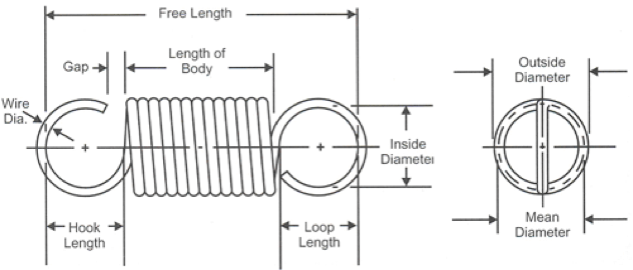
Whatever your extension spring design needs Industrial Spring has the capability to produce your part. We have a wide range of CNC and mechanical coiling machines that can manufacture custom extension springs with wire diameters as small as 0.015” or as large as 0.500” (0.381 mm to 12.7 mm) and any size wire in between.
Industrial Spring manufactures custom extension springs from all types of material. The most common material types for extension springs are music wire, hard drawn, stainless steel (type 302, type 316 and type 17-7 PH), oil tempered, chrome silicon, and phosphor bronze. We also produce extension springs in some of the more exotic types of material such as C276, Inconel 600 & 750, Monel, Beryllium Copper and others.
We stock several of these material types in different diameters in order to provide our customers with the shortest lead times possible.
Some Common Extension Spring Materials Include:
You can learn about the suitable uses of each material type in the Properties of Materials chart.
Standard extension springs are most commonly made with a cylindrical, constant outside body diameter. Industrial Spring can manufacture other body shapes for extension springs to fit your individual needs. Tapering the ends to a smaller diameter and increasing bend radii are typical methods for reducing the design stresses in the hooks on an extension spring.
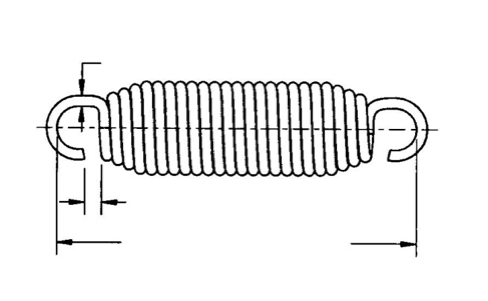
Various types of ends are used to attach an extension spring to the source of the force. Some examples include; hooks or eyes at varying positions or distances from the body of the spring, reduced and expanded eyes on the side or in the center of the spring, extended loops, threaded inserts and even rectangular or teardrop-shaped ends. The most common ends are the machine loop and crossover loop. These ends are made with standard tools in one operation and should be specified when possible to minimize cost. Other possible types of ends are illustrated below.
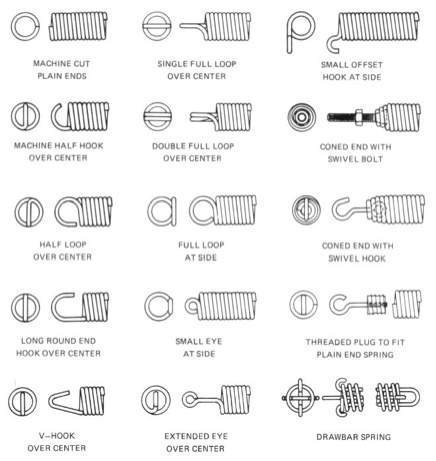
It is a common design requirement for the positional relationship of the hooks on an extension spring to be at a particular angle, inline or at 90° to each other, etc. This is sometimes required to assist with the spring being easily installed in the final application. Industrial Spring employs mechanical and laser probe devices on our equipment to insure these relationships are maintained to our customer’s specifications.
Stresses in loops are often higher than in the spring body. This can reduce spring performance particularly in cyclic applications. Generous bend radii in loops and reduced end coil diameters are two methods frequently employed to reduce stresses. In a full twist loop as shown in the illustration, bending stress reaches a maximum at the point shown in the left view below and torsional stress reaches a maximum at the point shown in the right view below. Stress at these locations is complex and can greatly impact the performance and cycle life of the spring in your application. Industrial Spring is here to assist with these complex design issues and can often make recommendations for small changes that can greatly improve the performance of the spring in your application.
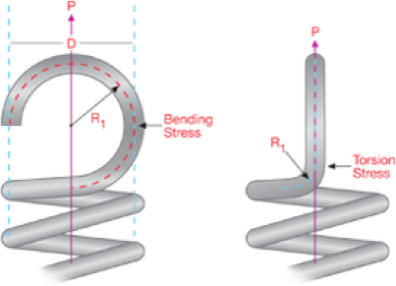
What information does Industrial Spring need to quote your extension spring?
The extension spring specification checklist below includes:
Contact Us Today To Learn How We Can Meet Your Extension Spring Production Needs.
